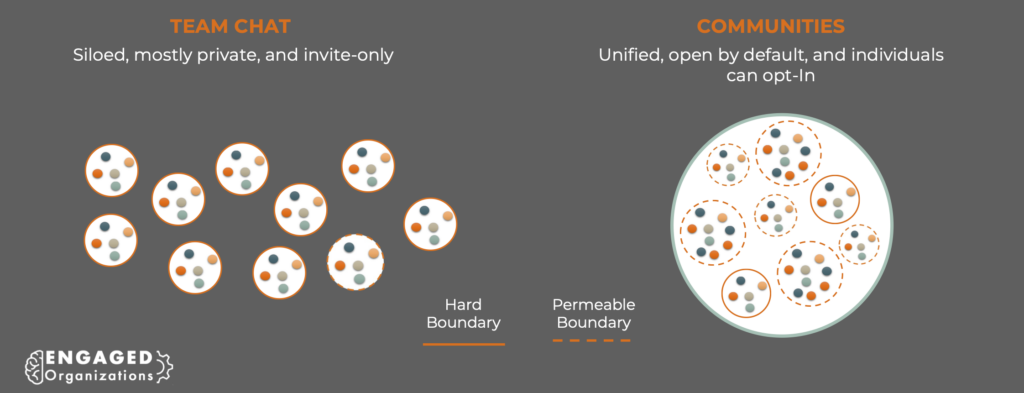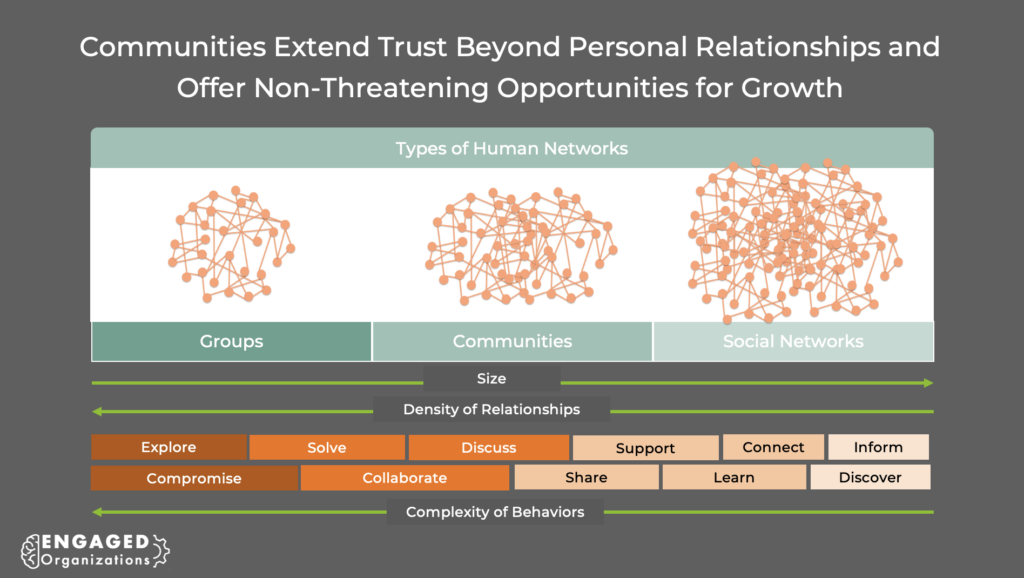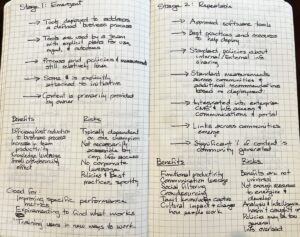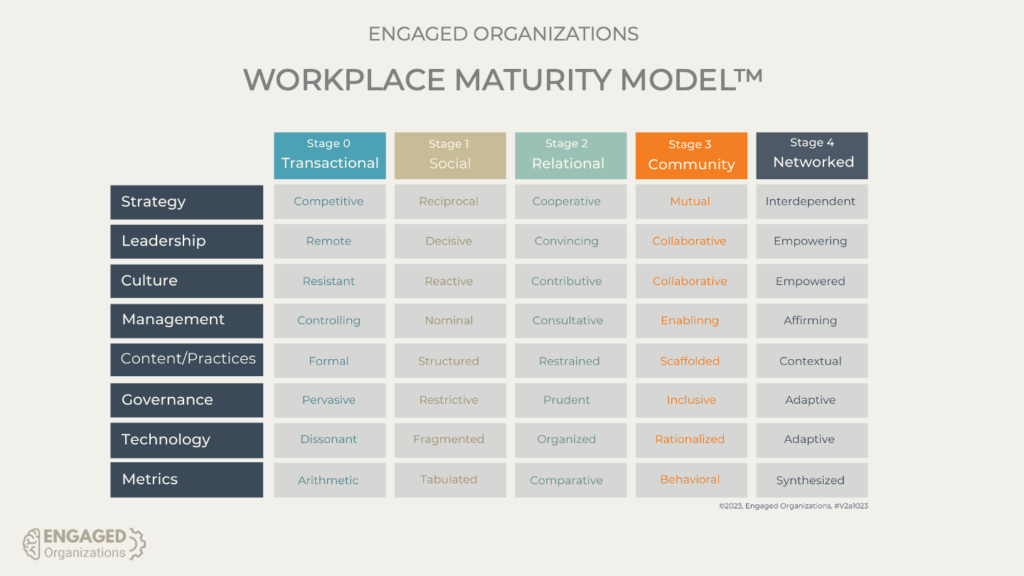Organizational Culture and Workplace Maturity Need to Change
Organizational and workplace maturity needs to evolve to keep up with the pace of change. Many start with digital transformation and technology efforts, but no investment in technology or the employee experience will effectively transform organizations if employees do not change how they behave, feel, and relate to each other. Fostering a more mature workplace community is key to helping individuals thrive. What do communities have to do with this?
Communities are the cultural frame in which individuals live. Community norms set expectations of baseline and exceptional behaviors; what’s acceptable and what is ideal. When communities are tacit instead of explicitly and intentionally cultivated, the expectations for individual behavior are left to chance. In tacit communities, when someone violates acceptable norms, they are retroactively addressed through policing, moderation, or other forms of discipline. Retroactive punishment is expensive and damaging, making it challenging to inspire positive behaviors. Instead of engaging intrinsic motivations, the only tools are extrinsic punishments and rewards, which are short-lived and fleeting.
Great leaders have always intuitively been community builders because they offer visions that inspire constructive action and collaboration. However, great leaders are not enough if the governance, infrastructure, and support systems make those behaviors hard.
I have spent the last 15 years studying, documenting, building, supporting, and advising community programs in an effort to articulate how strong communities operate and give others guidance. I believe advancing community-building skills will enable human potential – because I believe the communities in which people live and work enable or limit human potential.
What is a Community?
Historically, communities are thought of as the geographic area in which people live, but communities are networks of people and relationships, not places. Churches are communities, and while a church building makes it easier for the church community to come together, the building itself is not required. Individuals participate in many communities: religions, towns, schools, neighborhoods, interest groups, workplaces, and extended families. Many are nested, such as the school community that is part of a larger town community. Organizations are no different; they are both broad communities encompassing employees, partners, and vendors and have many more specific communities within them.

In organizations, communities are rarely explicit and digital spaces bring new challenges. Team chat spaces (Teams, Slack, etc.) are confused with community spaces (Yammer, Workplace from Meta, LumApps, etc.) because the have similar features.
Team chat tools are private by default, and individuals must be invited. The chat is optimized to be an ongoing central stream of chatter related to the project or team using it, and much of that information has expiring value (scheduling meetings, editing documents, logistical questions, etc). Community platforms are open by default, and individuals can join without permission. Critically search tools can access all public communities making information transparent and discoverable. Communities are ideal for expertise and content with persistent value, which could benefit employees across the organization. These are the spaces in which employees can ‘collide’ with others and form cross-organizational relationships.
From a more theoretical perspective, communities are distinguished from groups by the density of relationships – typically, everyone knows every other individual in teams or work groups. They are organized to execute a specific objective. Communities are distinguished from social networks by intention; communities form because of a shared purpose and strengthen when they are engaged in creating shared value or outcomes that address the shared purpose. Individuals in a community typically only know a portion of other community members but enough to trust the community because of their shared values, purpose, assumptions, experience, and behaviors.

Communities are Change Agents
At the heart of every community is learning, whether to learn about others in a neighborhood, run marathons in a running community, or learn how to live a more sustainable life in an environmental community. Learning is how change happens, and communities accelerate learning and change because communities are how individuals collectively take in, evaluate, apply, and make sense of new information. Because that sense-making is done collectively and iteratively, change is easy to accept, socially reinforced, and more likely to stick.
I often think of the emergence of impressionist art and how it was enabled by the salon culture of Paris even as it broke off into its own community. Silicon Valley is the center of the technology industry because the concentration of technologists created a community and made rapid learning, experimentation, and iteration possible. Communities are vital to innovation because they concentrate people with similar interests and experiences who can make sense of and rapidly apply new information and developments – and create the accepted truth of that information. For organizations that depend on innovation, investing in and cultivating communities will accelerate that innovation.
What is Needed to Foster Communities?

In 2008 I was IDC’s first industry analyst covering the social technology market. It is there that I first started noodling on a framework to help others understand the different components of enabling strong communities, inspired by the Capability Maturity Model and related offshoots I had seen as a consultant. This work then evolved into the Community Maturity Model that I iterated on at The Community Roundtable based on research, feedback from community professionals, and experiences with clients. A decade of research revealed patterns, evolution, and gaps that improved my understanding of how both customer/external communities and employee/internal community programs started and evolved – and, critically, what investments had the greatest impact when done at the right time.
In 2021, I left The Community Roundtable to start Engaged Organizations. I wanted to focus on organizational transformation, enterprise community programs, and the digital workplace, which is what inspired my research and work all along. I also wanted to collaborate more deeply with clients to understand the possibilities and challenges of community building within organizations at a more granular level.
Engaged Organizations’ Workplace Maturity Model
For the last two years, I have collaborated with a small handful of clients. At Microsoft Hardware, I have had the opportunity to support one of the most ambitious initiatives to use communities to evolve the culture from a “know-it-all culture” to a “learn-it-all culture.” This work has further informed my understanding of enterprise community programs, which can contain hundreds or even thousands of communities and requires that community management be a discipline of general management.
The needs of an enterprise community program team are quite different than those of a community team managing a customer community. Enterprise community teams spend more time on business, governance, program management, stakeholder, and leadership needs.
This new Workplace Maturity Model includes changes to terminology to reflect a different orientation, an additional maturity stage because of the complexity of these efforts, and updated thinking about how organizations progress.

Workplace communities and the culture they develop have a complex set of influences requiring new capabilities and priorities for strategy, leadership, culture, management, content and practices, governance, technology, and metrics. Each organization starts in a different place. Each organization has different priorities and biases. The Workplace Maturity Model will not indicate what an organization’s journey should be, but it will provide a map of the possibilities and influencing factors.
Here are some of the key aspects of each capability. Many of these items exist in organizations but must be redefined or adapted to prioritize the engagement, connection, and belonging required to accelerate learning and innovation.
Strategy: Shared Purpose/Shared Value vision, behavioral metrics, identified business and employee benefits, roadmap, and budget
Leadership: Executive support and engagement, stakeholder engagement, and emergent leadership.
Culture: Empowerment, sentiment, engagement rates, and ability to connect to work outcomes.
Management: Support, training, engagement, communication routines, and ability to connect to work outcomes.
Content / Practices: formality, rigidity, structure, access, discoverability, and synchronicity.
Governance: policies, guidelines, defined stakeholder groups, roles, integration with other functions.
Technology: functionality, integration, design for engagement, permissions.
Metrics: data, calculations, reporting, and connection to business outcomes.
Enterprise community programs have existed for decades, starting with in-person communities of practice. Digital community networks took off between 2008 – 2012 but started to lose attention with the rise of Slack, Teams, and chat features in business systems. Part of the challenge is the deluge of other channels. Employees are overwhelmed and cannot fix the problem individually because of network effects.
Enterprise social networks (ESNs) play a vital role in helping individuals navigate an overwhelming amount of content; they are the virtual street system of our organization, helping employees navigate more easily between different information sources and find trusted experts and expertise.
Enterprise community and digital workplace programs can accelerate the knowledge supply chain while connecting employees, helping them feel seen, and giving them access to opportunities. It’s a shared value that benefits the organization, leaders, AND each employee. There’s a lot to love about community approaches – and we need them more than ever.
Have questions? Interested in this work and how it could improve your organization’s culture and effectiveness?
How could we collaborate?



